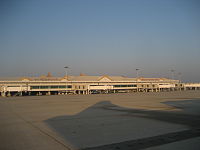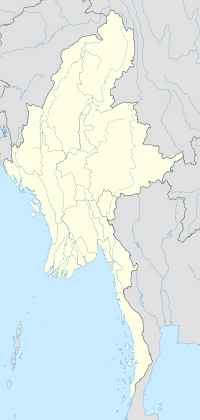- Mandalay International Airport
-
Mandalay International Airport
မန္တလေး အပြည်ပြည်ဆိုင်ရာ လေဆိပ်IATA: MDL – ICAO: VYMD Location of airport in Burma Summary Airport type Public Owner Government of the Republic of the Union of Myanmar Operator Ministry of Transportation Serves Mandalay Location Tada-U
Mandalay Region, MyanmarElevation AMSL 300 ft / 91 m Coordinates 21°42′08″N 095°58′41″E / 21.70222°N 95.97806°ECoordinates: 21°42′08″N 095°58′41″E / 21.70222°N 95.97806°E Runways Direction Length Surface ft m 17/35 14,003 4,268 Concrete Mandalay International Airport (Burmese: မန္တလေး အပြည်ပြည်ဆိုင်ရာ လေဆိပ်; (IATA: MDL, ICAO: VYMD)), located 35 km south of Mandalay in Tada-U, is one of only two international airports in Burma. Completed in 1999, the airport is the largest and most modern airport in the country, complete with a 14,000-foot (4267-m) runway and capacity to handle up to 3 million passengers a year. [1]
The airport receives mainly domestic flights, with the exception of international flights to Kunming, China.
Contents
Airlines and destinations
Airlines Destinations Air Bagan Heho, Myitkyina, Nyaung-U, Tachilek, Yangon Air KBZ Bagan Nyaung Oo, Heho, Yangon Air Mandalay Heho, Nyaung-U, Yangon Asian Wings Airways Bagan Nyaung Oo, Heho, Yangon China Eastern Airlines Kunming Myanma Airways Bhamo, Kalemyo, Kengtung, Khamti, Myitkyina, Pakokku, Tachilek, Yangon Yangon Airways Bagan, Heho, Kengtung, Myitkyina, Tachileik, Yangon Airport facilities
Opened on 17 September 2000, the terminal building can handle 1000 passenger arrivals and 1000 passenger departures per hour. The capacity of the airport is estimated to be three million passengers per annum, with expansion capacity to more than 15 million.[2] The site occupies a total area of 25,015 acres (10,123 hectares) and is located in central Burma about 21 miles (35 km) south of Mandalay, the nearest town being Tada-U. The journey from the airport to the city center of Mandalay takes approximately an hour by car.[1][3]
The concrete runway at Mandalay Airport is 14,000 feet (4267 m) long and 200 feet (61 m) wide, and long enough for any size of commercial aircraft to land. The car-park can accommodate 700 vehicles.[1][2]
The terminal is fitted with air conditioning, fire protection and emergency power generating systems. It is also equipped with six passenger lifts, one freight lift, three escalators and a baggage handling system. Three out of the six passenger boarding bridges can handle modern Boeing 747-400 aircraft. There is sufficient space for ten aircraft to anchor, and at a rate of 8 minutes per plane, aircraft of any size and make can touch down or take off to any destination abroad. MAGS (Mandalay Airport Ground Services) provides both passenger and cargo aircraft ground services.
Systems incorporated into the airport include VHF and HF SSB transmitters and receivers, a voice communication control system, an automatic terminal information system (ATIS), and an aeronautical fixed telecommunications network. The air traffic control tower is equipped with a variety of radar and navigation systems.
Passenger Facilities: 36 check-in desks, 8 gates, 6 air-bridges, 3 baggage claim belts, 11 short-term parking spaces, 6 long-term parking spaces, Post Office, Bank, Bureau de Change, Restaurant, VIP Lounge, Duty Free Shop, Newsagent/Tobacconists, Travel Agent, Tourist Help Desk, Car Rental
History
The Mandalay International Airport project was first conceived by the Burmese military government in the mid 1990s as a way to increase overall levels of foreign investment and tourism in Burma. With Yangon boasting the only other international airport for the whole country, the new Mandalay airport was regarded as crucial in achieving a planned passenger growth of 10% year on year. The hope was for Mandalay to become a hub for flights to other major Asian cities, in particular Beijing, Hanoi, Bangkok, Calcutta and Dhaka.[1]
Construction of the airport began in 1996, and the airport was officially opened in September 2000 at a cost of US$150 million. The project was financed through a long-term loan from the Thai ExIm Bank.
The largest and most modern international airport in Burma has never met the high expectations; instead it has come to represent the military junta's money-wasting white elephant projects. The much-expected passenger growth has yet to materialize due to the continued international boycott of Burma as a tourist destination. This has negatively impacted upon the number of people traveling to and from the country, and will continue to affect the ability of Mandalay airport operating to its full capacity. Further development projects at Mandalay Airport and other parts of the country, are undermined by this situation which seems unlikely to improve in the near future.[1]
References
- ^ a b c d e "Mandalay International Airport (MDL/VYMD)". Airport Technology. http://www.airport-technology.com/projects/mandalay/. Retrieved 2007-04-02.
- ^ a b "Quiet Debut for Mandalay Airport". Bangkok Post. September 21 2000. http://www.burmalibrary.org/reg.burma/archives/200009/msg00087.html. Retrieved 2007-04-02.
- ^ "MANDALAY INTL". World Aero Data. http://worldaerodata.com/wad.cgi?id=BM96826&sch=VYMD. Retrieved 2007-04-02.
Categories:- Mandalay
- Airports in Burma
Wikimedia Foundation. 2010.



